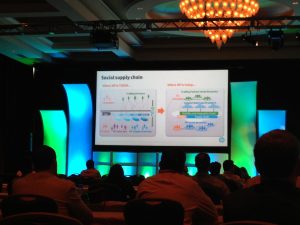In a post earlier this year, I wrote that companies looking for opportunities for supply chain innovation will ultimately find them at the intersection of Software, B2B Connectivity, and Social Networking — and that Supply Chain Operating Networks are leading the way in enabling that convergence.
This trend was certainly evident at GT Nexus’ Bridges 2014 User Conference last month. There were 500+ attendees from over 150 companies at the event, with speakers from leading companies such as Abercrombie & Fitch, Cargill, Caterpillar, CEVA Logistics, DHL, Guess?, Electrolux, Hewlett-Packard, Kuehne + Nagel, Johnson & Johnson, and Lenovo.
Supply chain visibility (Lenovo), global growth (GAP and Electrolux), the role of emerging technologies (Guess?), and assurance of supply (Caterpillar) were some of the key themes discussed at the conference (you can watch the Guess? and Electrolux presentations here). But if I had to pick one presentation that I believe best illustrates the direction companies need to move toward with their supply chains, it’s the one given by Naresh Shanker, CIO of the Printing and Personal Systems Group at Hewlett-Packard.
Shanker began his presentation by discussing how a new style of IT is emerging, driven by Mobility, Cloud, Social, and Big Data. This is part of HP’s corporate message for clients, but he also tied it back to HP and how these trends are shaping HP’s supply chain strategy and systems — a supply chain that includes 139 manufacturing sites and over 100 logistics service providers around the world, and includes a wide range of products, from inkjet printers to large data centers. Every 60 seconds, HP produces 105 PCs, 88 printers, 880 ink and toner cartridges, 7 network devices, 7 TB storage, and 7 servers.
In light of this scale and complexity, HP is striving to build the industry’s best supply chain, which includes:
- Migrating from a reactive to a Proactive Supply Chain
- Striving for Holistic Supply Chain Management
- Enabling a Predictive Supply Chain
- Driving towards an In-transit Inventory Allocation Model
- Establishing a Collaborative Supply Chain Network
- Evolving to the working style of the ”millennial” workforce
To get there, HP recognizes that it must embrace the new style of IT and create what it calls The Social Supply Chain, as the photo below from Shanker’s presentation illustrates:

As I wrote last year in A Pulse on Social Networking for Supply Chain Management, HP recognizes that social networking is not about socializing, but about facilitating people-to-people communication and collaboration, which is at the heart of managing and executing supply chain processes. And that Supply Chain Operating Networks like GT Nexus enable communities of trading partners to communicate, collaborate, and execute business processes in more efficient, scalable, and innovative ways.
Shanker, as well as several other speakers at the conference, echoed a key point Greg Johnsen, Chief Marketing Officer at GT Nexus, made in a recent episode of Talking Logistics: the need to focus on systems of engagement.
One of the things I hear a lot from companies is “We need to get our own house in order first before we can even think about our supply chain” — and I’ve come across a lot of executives responsible for “transformation” projects, but most of the initiatives are internally focused, such as standardizing on a single ERP platform across the enterprise. So I asked Greg, should companies wait to get their own house in order before focusing on their extended supply chain processes? Watch the clip below for his full response, but here’s a snippet of his comments:
You can no longer look inward, or just inward, you have to embark on initiatives that connect you with your suppliers, and your third party logistics providers, and your customers by the way…the road to customer growth and to customer differentiation, and brand differentiation, is supply chain, and so the systems that we’re talking about are not systems of record, they’re systems of engagement.
We’ve spent the last 30 or 40 years building systems of record to help us run our companies and record what has happened around our companies, and that recording is a little bit late, it’s not always accurate, but we’re very busy recording that picture and storing it, and the future is about how to engage with [outside trading partners and service providers].
[Systems of record and systems of engagement] complement each other and they relate to each other because we’re not just talking about how you engage, we’re talking about the data and information you get through those engagements and how you can fortify your systems of record.
As I commented last year, we’re still in the early stages of using social networking technologies for supply chain management, but as Hewlett-Packard illustrates, companies are starting to recognize the need to transform the way they connect, communicate, and collaborate with external trading partners. This requires companies to embrace the new style of IT, and GT Nexus and other Supply Chain Operating Networks — which bring together software, B2B connectivity, and social networking capabilities — are the new systems of engagement that are enabling this transformation.
Supply Chain Operating Networks are still evolving, and data quality issues and other challenges still remain, but I expect the rate of innovation and market adoption to accelerate in the months and years ahead as companies like HP invest more in this area, and providers like GT Nexus and its peers in the industry continue expand and enhance their solution footprints and educate the market.










